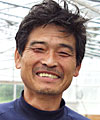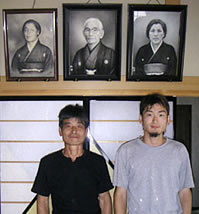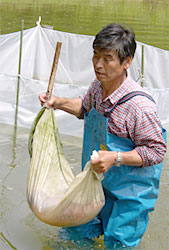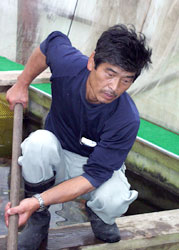
Featured Breeder
Seiki Igarashi (Igarashi Koi Farm)
Vice Director, Niigata Region, All Japan Nishikigoi Promotion Association |
 |
At the Igarashi Koi Farm located in Ozumi Tashiro, Nagaoka-shi, the Igarashi brothers breed almost all kinds of Nishikigoi. They focus on Gosanke but also breed other varieties such as Kawarimono. He is especially known as the creator of Kin Kikokuryu, a crossbreed of Kin Showa and Kumonryu. He has also created many high-quality Yamabuki Ogon.
|
 In 1965 when I was 16, I started the Koi business with my father. My father who was a lumber dealer was injured, which is how we got started in the Koi business. At first, we didn’t have any land and started to build ponds with one shovel. Mr. Izumiya gave us some of his Koi and trained us. At the time, I managed maybe half of Mr. Izumiya’s Koi. The first parent Koi I bought from him died at 4 months. But the rule in this field is that if you buy a Koi and become an owner, you are 100% responsible for them no matter what. I went through some tough times, but I think I now am finally recognized as a breeder. In 1965 when I was 16, I started the Koi business with my father. My father who was a lumber dealer was injured, which is how we got started in the Koi business. At first, we didn’t have any land and started to build ponds with one shovel. Mr. Izumiya gave us some of his Koi and trained us. At the time, I managed maybe half of Mr. Izumiya’s Koi. The first parent Koi I bought from him died at 4 months. But the rule in this field is that if you buy a Koi and become an owner, you are 100% responsible for them no matter what. I went through some tough times, but I think I now am finally recognized as a breeder.
 Nishikigoi live in the water, but soil is extremely important. If you put Koi from a field pond in corves, they normally lay on their side, but my Koi don’t. That means they have plenty of minerals. Even if you adequately fertilize the soil, if the soil is not good it will not metabolize, and the nutrition will not circulate. That’s why I enrich the soil in my pond at least 2 months in advance. Good soil stabilizes the water. Koi raised in a pond with good soil don’t need any antibiotics. Nishikigoi live in the water, but soil is extremely important. If you put Koi from a field pond in corves, they normally lay on their side, but my Koi don’t. That means they have plenty of minerals. Even if you adequately fertilize the soil, if the soil is not good it will not metabolize, and the nutrition will not circulate. That’s why I enrich the soil in my pond at least 2 months in advance. Good soil stabilizes the water. Koi raised in a pond with good soil don’t need any antibiotics.
At our farm we raise a variety of Koi, but I believe that the responsibility of the breeder is to develop a discerning eye for selecting and sorting Tategoi. Kohaku and Taisho Sanshoku (Sanke) can be selected based on their body conformation and pattern to some extent. But Kawarimono literally changes. The seasons can even affect the changes, so you have to have an eye for selecting which Koi will become Tategoi and which will not. This is a far from easy task. For example, it takes time to select and sort Yamabuki. It has only one color. So what do you make your judgments on? First you look at how the head shines, then how the Fukurin shine, and how the scales are aligned, and that there are no Shimi, etc.
 My advice to all Koi lovers as to become a good selector of Koi is to always appreciate a number of good Koi. You should broaden your world by going to Koi shows and seeing many highly-praised Koi. The good and bad points of Koi is comparable, so when you can tell the difference between your Koi and others’, that is a sign of a good eye. Koi lovers normally look only at the patterns. On the other hand, we breeders have an image that we want to create, so the judgment standards of what is good and not good are different. In many cases, the breeders’ judgment and that of the judges’ is different. My advice to all Koi lovers as to become a good selector of Koi is to always appreciate a number of good Koi. You should broaden your world by going to Koi shows and seeing many highly-praised Koi. The good and bad points of Koi is comparable, so when you can tell the difference between your Koi and others’, that is a sign of a good eye. Koi lovers normally look only at the patterns. On the other hand, we breeders have an image that we want to create, so the judgment standards of what is good and not good are different. In many cases, the breeders’ judgment and that of the judges’ is different.
 What I base my judgments on are body conformation and quality. Quality can mean a lot of things, but for example in Kohaku, I look at the Shiroji, Kiwa (sharpness of the edges of the patterns) and scale. A good Koi has deep colors in the scale. What I base my judgments on are body conformation and quality. Quality can mean a lot of things, but for example in Kohaku, I look at the Shiroji, Kiwa (sharpness of the edges of the patterns) and scale. A good Koi has deep colors in the scale.
Genealogy is important, but there are varieties which don’t reflect it very much. Kohaku and Taisho Sanshoku (Sanke) tend to keep their genealogy. But Showa Sanshoku don’t inherit their genealogy; a good Koi may suddenly appear, or no good Koi are born from a not-so-bad genealogy. It may sound as if assessment of Koi is very difficult, but the important thing is to understand that Koi is a product of nature and each one is unique. It’s all in cultivating your sensitivity: when you see beautiful Koi, you think they’re beautiful. This is not rocket science. It will come naturally when you raise them for more than 4 years.
Another important thing is to keep the Koi for a long time; don’t let them die. Nishikigoi are strong fish, but many Koi lovers make the mistake of devoting too much attention to them and eventually killing them. Koi may be killed by too much food, bad management, and diseases. These can be resolved if you handle them correctly. If you’re Koi become sick, don’t panic and ask us breeders.
We can give you some solutions.
From that perspective too, I hope you will make maximum use of INPC.
|
|



